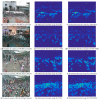Meta-Knowledge and Multi-Task Learning-Based Multi-Scene Adaptive Crowd Counting
- PMID: 35591010
- PMCID: PMC9104539
- DOI: 10.3390/s22093320
Meta-Knowledge and Multi-Task Learning-Based Multi-Scene Adaptive Crowd Counting
Abstract
In this paper, we propose a multi-scene adaptive crowd counting method based on meta-knowledge and multi-task learning. In practice, surveillance cameras are stationarily deployed in various scenes. Considering the extensibility of a surveillance system, the ideal crowd counting method should have a strong generalization capability to be deployed in unknown scenes. On the other hand, given the diversity of scenes, it should also effectively suit each scene for better performance. These two objectives are contradictory, so we propose a coarse-to-fine pipeline including meta-knowledge network and multi-task learning. Specifically, at the coarse-grained stage, we propose a generic two-stream network for all existing scenes to encode meta-knowledge especially inter-frame temporal knowledge. At the fine-grained stage, the regression of the crowd density map to the overall number of people in each scene is considered a homogeneous subtask in a multi-task framework. A robust multi-task learning algorithm is applied to effectively learn scene-specific regression parameters for existing and new scenes, which further improve the accuracy of each specific scenes. Taking advantage of multi-task learning, the proposed method can be deployed to multiple new scenes without duplicated model training. Compared with two representative methods, namely AMSNet and MAML-counting, the proposed method reduces the MAE by 10.29% and 13.48%, respectively.
Keywords: crowd counting; meta-knowledge; multi-scene adaptive; multi-task learning.
Conflict of interest statement
The authors declare no conflict of interest.
Figures





Similar articles
-
One-Shot Any-Scene Crowd Counting With Local-to-Global Guidance.IEEE Trans Image Process. 2024;33:6622-6632. doi: 10.1109/TIP.2024.3420713. Epub 2024 Dec 3. IEEE Trans Image Process. 2024. PMID: 38963733
-
Crowd Counting Using Meta-Test-Time Adaptation.Int J Neural Syst. 2024 Nov;34(11):2450061. doi: 10.1142/S0129065724500618. Int J Neural Syst. 2024. PMID: 39252679
-
Meta-Knowledge Learning and Domain Adaptation for Unseen Background Subtraction.IEEE Trans Image Process. 2021;30:9058-9068. doi: 10.1109/TIP.2021.3122102. Epub 2021 Nov 2. IEEE Trans Image Process. 2021. PMID: 34714746
-
Deep Learning-Based Crowd Scene Analysis Survey.J Imaging. 2020 Sep 11;6(9):95. doi: 10.3390/jimaging6090095. J Imaging. 2020. PMID: 34460752 Free PMC article. Review.
-
Advances and Trends in Real Time Visual Crowd Analysis.Sensors (Basel). 2020 Sep 7;20(18):5073. doi: 10.3390/s20185073. Sensors (Basel). 2020. PMID: 32906659 Free PMC article. Review.
References
-
- Saleh S.A.M., Suandi S.A., Ibrahim H. Recent survey on crowd density estimation and counting for visual surveillance. Eng. Appl. Artif. Intell. 2015;41:103–114. doi: 10.1016/j.engappai.2015.01.007. - DOI
-
- Gao G., Gao J., Liu Q., Wang Q., Wang Y. CNN-based density estimation and crowd counting: A survey. arXiv. 20202003.12783
-
- Zhang Y., Zhou D., Chen S., Gao S., Ma Y. Single-Image Crowd Counting via Multi-Column Convolutional Neural Network; Proceedings of the IEEE Conference on Computer Vision and Pattern Recognition; Las Vegas, NV, USA. 27–30 June 2016; pp. 589–597.
-
- Sam D.B., Surya S., Babu R.V. Switching Convolutional Neural Network for Crowd Counting; Proceedings of the IEEE Conference on Computer Vision and Pattern Recognition; Honolulu, HI, USA. 21–26 July 2017; p. 6.
-
- Chen X., Bin Y., Sang N., Gao C. Scale Pyramid Network for Crowd Counting; Proceedings of the IEEE Winter Conference on Applications of Computer Vision; Waikoloa, HI, USA. 7–11 January 2019; pp. 1941–1950.
MeSH terms
Grants and funding
LinkOut - more resources
Full Text Sources

